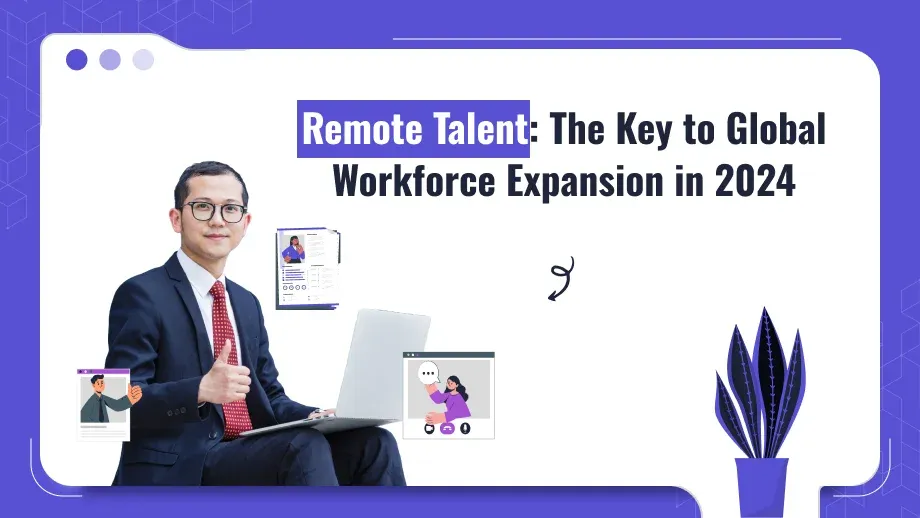
Remote talent has turned from an accessory to a necessity. What was only a temporary arrangement for some businesses during the COVID-19 outbreak has become a permanent fixture for many. Hire remote talent gives you unparalleled adaptability and worldwide skills that weren’t conceivable 10 long years ago. By extending your enrollment pool over borders, you can attract highly gifted professionals from different backgrounds, cultures, and time zones.
For HR professionals, CHROs, and CEOs, this is a challenge and an opportunity. They are required to enroll, oversee, and bolster further specialists productively while keeping up with the law and not losing company culture in the virtual world. This article will look at the best ways to contract and manage inaccessible talent and give HR leaders the actionable insights they need to succeed in this new world.
How Big is Remote Hiring in 2024?
Remote talent continues to grow in 2024, with over 60% of companies actively hiring for remote positions. This isn’t constrained to one industry—companies over the board are recognizing the esteem of a distributed workforce. Here’s a breakdown:
High Demand in Tech
Tech companies have been driving the talent acquisition charge, with parts like software developers, data analysts, and cybersecurity specialists being the most in request. Numerous companies are finding it simpler to contract profoundly specialized experts remotely than through conventional neighborhood recruitment.
Expansion into Other Sectors
While the tech was the first to go remote, other businesses like promoting, healthcare, and instruction are now turning to remote talent to fill key parts. For illustration, numerous healthcare companies are enlisting inaccessible therapeutic coders, telemedicine suppliers, and healthcare consultants, whereas instructive teachers are recruiting remote guidelines designers and online teachers. These talent acquisition remote positions are getting to be more common in different sectors.
Remote Talent Acquisition Software
The growth of remote work has led to a surge in its acquisition of software. These tools help companies oversee everything from work postings and applications to candidate assessments and onboarding. By automating much of the recruitment handle, these systems allow HR teams to handle the increased volume of applications that come with recruiting from a global talent pool.
Remote Work is the Future of Talent Acquisition
Global Talent Pool
With traditional office-based hiring, companies are limited to talent within commuting distance. it securing expels geographical boundaries, so companies can get to a global talent pool. This is particularly valuable for businesses that require specialized abilities like tech, back, and building. In today’s competitive world, companies that limit their hiring to local candidates may struggle to fill key positions.
Cost Savings
Hiring ability spares noteworthy costs. With no office space, utilities, or in-office advantages, companies see decreased overheads. Ability securing kills movement costs and other calculated costs of moving employees across cities or countries. This is a big win for companies looking to get the most out of their budget.
Increased Productivity
Studies appear farther specialists regularly outflank their office-based partners. With fewer office distractions, more adaptability to oversee their time, and a personalized workspace, remote employees can deliver high-quality work. Companies that enlist ability report higher representative engagement, which leads to superior by and large performance.
Improved Employee Retention
Employees who can work from home or anywhere in the world are generally happier and more fulfilled in their work. They are less likely to burn out, have a better work-life balance, and feel more secure with their employer, which leads to greater engagement and lower turnover. This makes talent acquisition remote positions an attractive and sustainable strategy for businesses.
6 Tips for Recruiting Remote Talent
Leverage Global Job Boards
Use worksheets that specialize in further work, such as We Work Remotely, Remote. co, and LinkedIn. These platforms attract candidates who are as of now aware of the challenges and benefits of working remotely. Tapping into a global talent pool gives you access to a diverse run of professionals with different abilities and backgrounds, widening your reach past nearby limits.
Write Compelling Job Descriptions
Make sure your job descriptions highlight the key benefits of further work. Adaptability, independence, and strong work culture are gigantic offering focuses for the best ability. By clearly emphasizing these viewpoints, you make the work more alluring to those who esteem autonomy. Counting the utilize of a Talent Management System in your work posting will too console potential candidates that the company is organized and well-prepared to oversee inaccessible employees effectively.
Use Remote Talent Acquisition Software
Automate your hiring process using tools outlined specifically for further enlistment. This program makes a difference in streamlining everything from candidate screening to onboarding, giving a smooth and proficient encounter for candidates. Additionally, integrating background search software ensures that all enlists are verified completely, notwithstanding of their location.
Conduct Virtual Interviews
Virtual interviews are significant for surveying a candidate’s capacity to communicate and collaborate in a further work environment. Utilize video interviews to see how candidates handle challenges unique to remote work, such as planning over time zones. Openly discuss the part and importance of communication amid these interviews to emphasize how basic it is in remote teams.
Offer Competitive Benefits
Remote employees value flexibility and work-life adjustment, so advertising benefits like flexible hours, wellness programs, and career improvement openings can set your company apart. Also, utilizing the best HRMS and payroll software in India makes a difference you overseeing the assorted needs of your workforce, counting compensation and compliance for further workers.
Assess Remote-Specific Skills
During the meet handle, make sure to evaluate candidates for aptitudes that are fundamental in an inaccessible work environment, such as self-discipline, time administration, and problem-solving capacities. Utilizing a Talent Management System can offer assistance you tracking these appraisals and comparing candidates more effectively.
Elevate your hiring strategy by tapping into remote talent!
Our platform makes it easy to source, manage, and collaborate with top professionals from anywhere. Transform your team dynamics today!
7 Hacks to Attract the Best Remote Talent to Your Company
Offer Flexible Hours
Remote workers highly value the capacity to set their plans. Numerous remote workers select this work fashion to adjust proficiency and personal responsibilities, so offering flexible hours is key. Don’t implement unbending 9-to-5 plans; instep, center on comes about. Let representatives work amid their most productive hours. This adaptability will make your company more appealing to top talent, especially those balancing childcare or other responsibilities.
Invest in Cutting-Edge Technology
Equip your father groups with the best devices for communication, collaboration, and productivity. Platforms like Slack, Zoom, and Trello, not it were upgrade communication but illustrate that your company is arranged to bolster inaccessible specialists. Giving stipends for domestic office setups (work areas, ergonomic chairs, screens) and utilizing background search software for safe hiring will boost job satisfaction and productivity.
Use Non-Intrusive Remote Employee Monitoring
While execution following is vital, further laborers esteem belief and independence. Utilize non-invasive instruments like Hubstaff or Time Specialist that permit further representative observing without micromanaging. Center on the results-based following or maybe minute-by-minute oversight. These frameworks track efficiency regarding representative security and cultivate a culture of responsibility and trust.
Provide Career Development Opportunities
Offering further representative openings for progression, authority preparation, and mentorship programs will set your company separated. Inaccessible specialists still need to develop, and by utilizing a talent management system, you can track their advancement and outline clear career paths during recruitment. This shows candidates they can grow within the company, indeed from a distance.
Foster a Strong Remote Culture
Building a solid company culture is one of the biggest challenges for remote teams, but it’s also basic for keeping representatives locked in. Standard virtual team-building activities, like online games, virtual happy hours, or lunch-and-learn sessions, cultivate a sense of community. Encourage open communication and make space for casual, non-work-related intuition to help workers feel connected to their colleagues and the company’s mission.
Promote Work-Life Balance
Remote laborers are particularly sensitive to burnout, so it’s critical to make a work culture that advances adjust. Offer wellness programs, and mental wellbeing days, and encourage employees to take time off when required. Supporting work-life adjustment is pivotal in drawing in and holding the best ability, as specialists who feel valued and not overworked are more likely to remain and perform at a tall level.
Offer Competitive Compensation
Salary desires for it can shift broadly depending on where candidates are found. Be that as it may, best inaccessible experts anticipate competitive benefits. Inquire about the going rates in the locales you’re contracting from and offer competitive compensations along with a full run of benefits (healthcare, retirement plans, etc.). Adaptability, independence, and development openings are key offering focuses, but a reasonable and competitive compensation is a enormous figure in pulling in talent.
Managing Remote Talent: Best Practices for HR Leaders
Performance Monitoring
Setting clear, measurable goals is key for remote employees. The instep of tracking hours worked, switch to results-based execution administration. Utilize Trello or Asana to set venture timelines, dole out errands, and track progress. Tools like remote employee monitoring software deliver your knowledge into productivity without micromanaging. Center on outcomes, not how workers spend each minute of their day.
Regular Communication
One of the biggest challenges of remote work is keeping up open communication. Plan normal check-ins with representatives to make sure they’re adjusted to company objectives and feel upheld. Day-by-day stand-ups or week-after-week meetings through video calls (Zoom or Microsoft Teams) can keep everybody connected. Empower offbeat communication for group members in diverse time zones to keep the workflow moving, indeed when representatives aren’t working at the same time. The role and importance of communication cannot be overstated in remote teams.
Collaborate Effectively
To overcome the geographical barriers of remote work, use team (up) tools like Google Workspace, Slack, and Trello to facilitate teamwork across different time zones. Set up virtual workspaces where team members can collaborate in real time. This or not This makes a sense of community and permits the simple sharing of thoughts and feedback.
Engage Remote Teams
Engaging remote teams can be intense, but it’s vital for maintenance and efficiency. Recognize achievements through virtual awards or thank-yous during team meetings. Organize virtual social occasions, like trivia games or happy hours, to make workers feel connected. Encouraging work-life adjustment, as mentioned earlier, also plays a huge part in keeping remote laborers cheerful and engaged.
The Role of Technology in Remote Talent Acquisition
Applicant Tracking Systems (ATS)
An applicant tracking system is essential to manage the recruitment process. These stages permit HR groups to post work postings, sort through hundreds of applications, and communicate with candidates effectively. Frameworks like Workable, Nursery, and BambooHR automate candidate sorting based on predefined criteria making the contracting preparation more organized and less time-consuming.
Remote Talent Acquisition Software
Specialized inaccessible remote talent acquisition software rearranges enlisting preparation by giving apparatuses for virtual interviews, candidate appraisals, and record administration. With the increment in applications for inaccessible positions, these instruments offer assistance to HR groups scaling their endeavors while keeping in individual touch with candidates. Prevalent stages like Recruitee or JazzHR make it simple to oversee worldwide contracting at scale.
HRMS Payroll Software
Managing payroll for a global remote workforce can be complex due to distinctive charge controls and compliance necessities over districts. Utilizing the best HRMS finance computer program makes a difference oversee representative installments, assess conclusions, and benefits organizations for inaccessible groups spread over numerous areas. This guarantees compliance with neighborhood charge laws and makes finance administration more seamless.
Compliance When Hiring Remote Talent
Legal Compliance
Labor laws change from nation to nation so companies must guarantee they comply with neighborhood laws on working hours, emoluments, and representative rights. This is particularly critical when enlisting ability from different locales. Falling flat to comply with neighborhood labor laws can result in fines, legitimate debate, or reputational harm. It’s suggested to counsel with lawful specialists who specialize in worldwide work or utilize stages like Deel or Remote which help oversee global hiring compliance.
Tax Compliance
Cross-border further enlisting makes assess commitments for both the company and the worker in different nations. HR leaders must get neighborhood assessment laws and charge arrangements between nations to dodge punishments. Utilizing HRMS payroll software can offer assistance calculate assess conclusions precisely and guarantee all essential filings are made on time.
Data Privacy
Its work involves handling sensitive data over different wards so data privacy is best of intellect. Companies must comply with worldwide information assurance laws such as GDPR when putting away and preparing representative data. HR teams must guarantee the company’s data handling hones are straightforward and lawfully compliant, utilizing secure stages that protect sensitive information.
Remote Work Contracts
It’s basic to have clear, lawfully sound contracts for remote employees. These contracts should detail the terms of employment including working hours, recompense, benefits, and execution desires. They must also indicate which country’s laws will oversee the working relationship to avoid jurisdictional issues.
The Future of Remote Talent in a Hybrid World
Remote work will be the future of work in the office, known as the hybrid living room. Flexibility and convenience combined with remote work and the collaborative benefits of working in person. Here’s what HR leaders are required to consider:
Hybrid Talent Acquisition Strategies
Companies need to develop talent acquisition strategies for both remote and in-office roles. This flexibility allows businesses to attract a wider pool of candidates – those who prefer remote work and those who thrive in an office environment. Implementing hybrid models means companies can retain valuable employees who need the balance of both.
Technology and Collaboration
As hybrid work becomes more mainstream, the demand for seamless collaboration tools will only grow. Investing in platforms that support both remote and in-office employees is crucial. Tools like Microsoft Teams, Slack, and Google Workspace will be key to keeping hybrid teams productive and connected.
Future Workforce Flexibility
Flexibility will be key as workforces evolve. Companies must offer a range of work options – fully remote, hybrid, or in-office – to stay competitive. This flexibility will help businesses attract the best talent in an increasingly flexible job market.
Conclusion
In 2024 and beyond, having the ability to attract, hire, and manage remote talent is a business advantage for all industries. As remote and hybrid work becomes the norm, HR leaders, CHROs and CEOs need to get with the times and new technologies and practices to stay in the global talent market.





